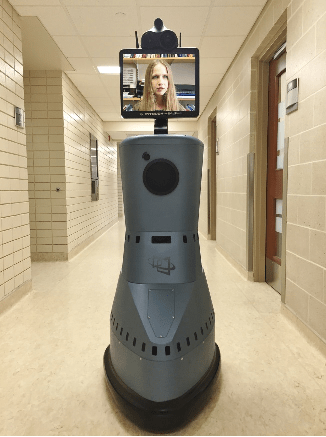Released on August 9, 2017
Remote Presence Technology Continues to Expand in Northern Saskatchewan
More patients in Stony Rapids will now be able to receive care in their home community as a result of government’s $500,000 commitment to expand the use of Remote Presence Technology (RPT).
“This innovative technology allows patients to access medical experts from their home community,” Rural and Remote Health Minister Greg Ottenbreit said. “This is particularly important in rural and remote areas where patients might otherwise have to travel to receive more specialized health services.”
RPT enables health care providers to perform real-time assessments, diagnostics, and patient management from a remote location, through either a mobile robot or smaller portable hand-held device known as a “doc-in-a-box”.
“Living in a remote community, we’re far from medical services that are not available locally,” Stony Rapids resident Connie Fossenier said. “This technology is an advancement and improvement for the far north communities.”
“With this collaboration, that increases access to specialized care, we are significantly improving the outcomes and quality of care for the communities that we serve,” Athabasca Health Authority CEO Darryl Galusha said.

RPT was pioneered in Saskatchewan by Dr. Ivar Mendez, the Fred H. Wigmore Professor and Unified Head of the Department of Surgery at the University of Saskatchewan. He played a key role in the Pelican Narrows pilot and the subsequent expansion in partnership with Dr. Veronica McKinney, Director Northern Medical Services and Dr. Tanya Holt, pediatric intensivist, University of Saskatchewan.
“We are very pleased with the expansion of the Remote Presence Robotic Program to the northern-most Regional Health Center in the province,” Dr. Mendez said. “This expansion will allow access to specialized care in real time for the population of Stony Rapids and surrounding communities. Saskatchewan is leading the country in using advanced technologies for the delivery of health care to remote and rural locations.”
Government committed $500,000 annually to expand RPT in Northern Saskatchewan following a successful Pilot in Pelican Narrows in 2014. Stony Rapids is the second community to receive a robot as part of the expansion, following La Loche earlier this year.
“We are very excited to be able to introduce this technology into one of the most northern and remote communities in our province,” Dr. McKinney said. “The ability to provide access to care where and when it is needed will be an incredible change one could only have previously dreamed of. The ability to receive care in the community allows family members to remain by the patient’s bedside and to be more actively involved in the patient care and support, both of which are critical to improved outcomes. We are most grateful for this opportunity and look forward to the potential of this technology.”
RPT is initially being used for pediatric emergency assessment in La Loche and Stony Rapids while the Ministry of Health explores additional services offerings and works to identify priority sites for further expansion.
“It is critical that we continue to expand the remote presence program in Saskatchewan in order to narrow the gap in health care access for remote communities,” Dr. Holt said. “Stony Rapids is an important and exciting next step.”
-30-
For more information, contact:
Shirley Xie
Health
Regina
Phone: 306-787-4083
Email: shirley.xie@health.gov.sk.ca
Angela White
Department of Surgery, College of Medicine, University of Saskatchewan
Saskatoon
Phone: 306-966-7323
Email: surgery.communications@usask.ca

